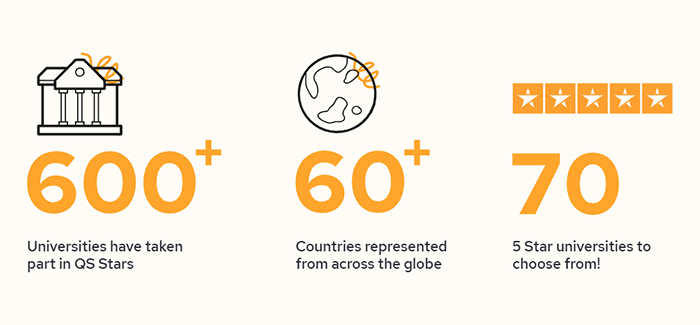QS Stars is a university rating system used by hundreds of institutions around the world. It’s an opt-in university rating system, where participating universities are evaluated in a broad range of categories such as teaching, research, facilities, available programmes, and environmental impact. Universities are rated up to five Stars for each category, as well as an overall rating of up to 5+ Stars. The aim is to help prospective students get an in-depth picture of the strengths of different universities – covering everything from core criteria and learning environment, to specialist programmes and advanced criteria.
How can QS Stars be used?
The full QS Stars university ratings can be explored in an interactive online table, which allows users to filter the results by location, number of Stars rating, and overall rating. Use this table to identify QS Star-rated universities in the countries you want to study in, and view the results in specific categories by using the yellow dropdown list in the left-hand column. You can then click on a university’s name, which will take you to the university’s dedicated profile page for more information, including Stars ratings for all categories the institution has been rated for. You might also find QS Stars badges on participating universities website.
How does QS Stars rate universities?
There are 14 possible categories in which universities can be rated. Three of these are mandatory, covering the core areas of Teaching, Employability, and Internationalisation. Universities have the option of choosing between research and academic development and can also choose whether to have their learning environment assessed based on either campus facilities or online/distance learning provision. There’s also a category to highlight the strength of their specialist programmes. Finally, they choose two of four optional categories: Innovation, Arts and Culture, Social Responsibility, or Inclusiveness. In 2021 we introduced a new category, Environmental Impact, to align the methodology with SDG goals. In this category, universities have a chance to showcase their efforts towards environmental sustainability, which they can opt for individually or alternate to the categories of Advance Criteria.
For details on how each category is assessed, click here.
How is QS Stars different to a university ranking?
Like a university ranking, QS Stars can be used to compare universities. However, the QS Stars rating system provides a much more in-depth assessment, going into much greater detail and drawing on more extensive data. And instead of receiving a ranking position (such as first, second or third place), universities are given a Stars rating out of five and an overall rating of up to 5+ Stars.
How many universities have been rated?

Who is QS Stars for?
QS Stars is intended to help prospective students gather information, in order to decide which university is best for them. The fact that each university is awarded a Stars rating for multiple categories means students can quickly identify the strongest points of an institution, as well as searching for universities with high ratings in the areas that matter most to them. For universities, QS Stars provides a means of presenting their strengths in more detail than is possible through the rankings, as well as identifying areas for improvement.

